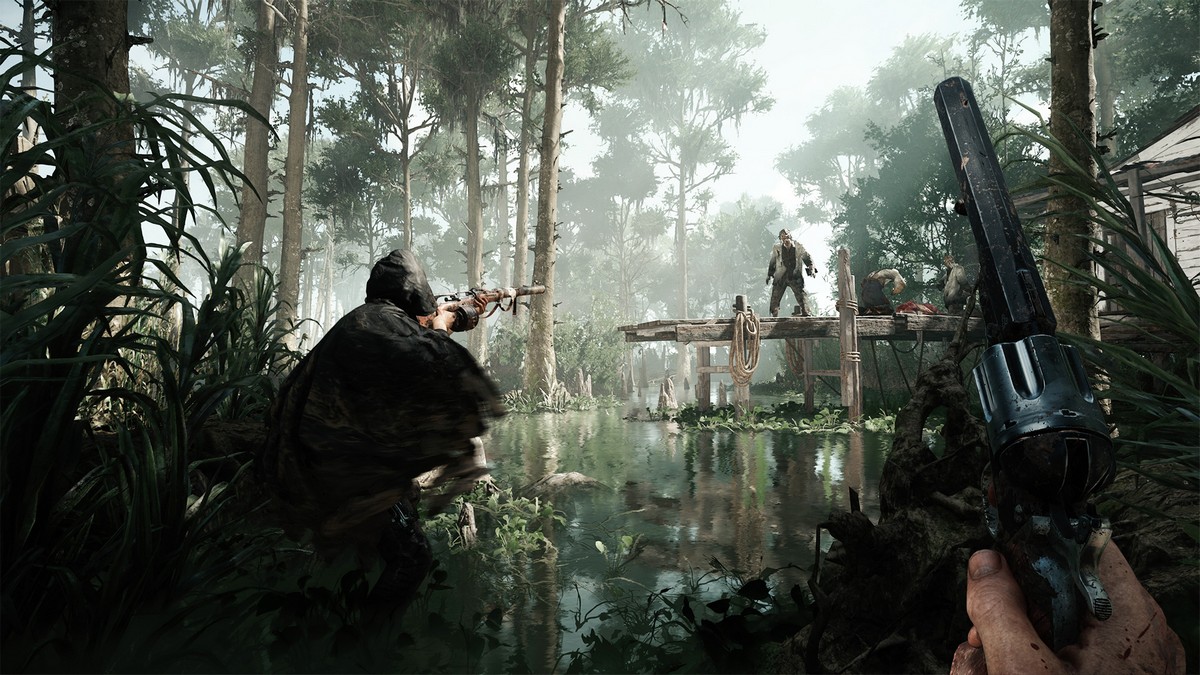Hunt: Showdown Review
Hunter or hunted?

The fantasy of being a monster hunter is pretty strong. From Van Helsing to Buffy, the idea of being the one person badass enough to run towards the monsters is enticing, especially if there’s a tangible reward on offer. In Hunt: Showdown, up to nine other people have had the same idea. Things could get messy. Could the real monster be… humanity itself?!
Set in the swamps of the Deep South, Hunt pits Wild West-era weaponry against Eldritch horror to great effect. Borrowing a little from the open-world nature of the battle royale genre, you’ll need to find clues to the local abomination’s location, either alone or in a team of up to three. Along the way, you’ll pass ruined farms, decrepit churches and rotten swamplands.

Something’s seriously… wrong here. Corrupted locals sprout hives of poisonous insects whilst crippled horses lay screaming on the ground, almost begging for a merciful bullet. It’s really not a pleasant place to be.
The atmosphere is extraordinary. The heat of the bayou almost radiates from the screen, from the swamp-soaked wooden boards to the muddy, sweaty basements of the nearby buildings. The game’s sound design is pitch-perfect, too. Distant gunshots feel entirely natural and footsteps are noticeably varied over different types of ground.

Every environmental detail plays into this – those horses aren’t just good for atmosphere; they’ll also release a terrifying whinny if another player gets too close. Flocks of easily spooked birds and dry, snappable twigs also make a good headset a must if you’re looking for full tactical information on your opponents.
And you’ll need to make sure you’re keeping track of them. After an initial grace period, death is permanent in Hunt. If your hunter goes down, they’re taking all of their equipment and upgrades with them. It’s a fairly simple way to ramp up the tension, but the very real threat of death will be on your mind before any encounter. Guns are also permanent, including those you find in the field, so it’s entirely possible to get the drop on a high-level player and take their lovely engraved rifle for yourself.

Generally, equipment is purchased through cash earned at the end of each mission, through a strangely complicated web of menus. Disappointingly for a full-priced release, there is also a free-to-play style microtransaction store, selling the usual currency packages for ludicrous prices. I’ve seen no evidence of the ability to ‘pay-to-win,’ but it’s certainly worth pointing out.
One of the first things you’ll notice is the way Hunt controls. Actually firing a gun is much more complicated than in other games, with melée a far quicker and quieter way of dealing with the majority of foes, if you can get close enough. Aiming a gun takes multiple button inputs and even then you’ll be relying on ancient iron sights or, at best, a tiny circular scope. The game insists on placing its crosshair in the lower third of the screen, Destiny-style, which I hated vehemently at first.

However, learning to master the quirky weapon system gives Hunt’s combat a feel of its own and, after a while, I came to appreciate it for what it was – an extension of the player’s frailty. There is also a more traditional ‘gunslinger mode’ available, with controls far more similar to a standard FPS but honestly, now that I’ve got used to this I wouldn’t want to switch.
The boss battles, when taken on their own, are a little bland. Bosses generally won’t leave their lairs, making it trivial for a lone player to pop in, fire off a few shots, then pop out to reload and heal up. Of course, this only works until another player shows up and murders you where you stand for being so damn boring.

Once the boss is down, there’s an agonising wait for the bounty to become available, during which your location is broadcast to the rest of the players like a Lovecraftian Bat-signal. In a genius move, each boss creature drops two bounties, making the corpse worth fighting over even if the player who dealt the killing blow is long gone. This, for me, is the best part of the game, lying in wait for the inevitable gold rush.
Quickplay mode is far more overtly battle royale in nature, albeit slower, stealthier and far more tactical than the average match of Fortnite or Apex Legends. There are no boss monsters to hunt – instead, players are after the Wellspring, a source of power, in what is essentially a free-for-all capture the flag mode. Guns are found strewn across the landscape, and the winning player gets to keep their randomly-generated hunter along with any equipment they gathered along the way. It’s an enjoyable distraction, but it doesn’t quite hit the highs of Hunt’s main game mode.
Hunt: Showdown is a little bit DayZ, a little bit PUBG and a little bit Resident Evil. This initial release is strong, with plenty of room to expand. Eventually, new maps, weapons and enemy types will be needed to maintain interest. Hunt: Showdown may not technically be a battle royale game, but it shares enough of the genre’s DNA that I wouldn’t be surprised to see a battle pass in the near future.
[Reviewed on PC]
